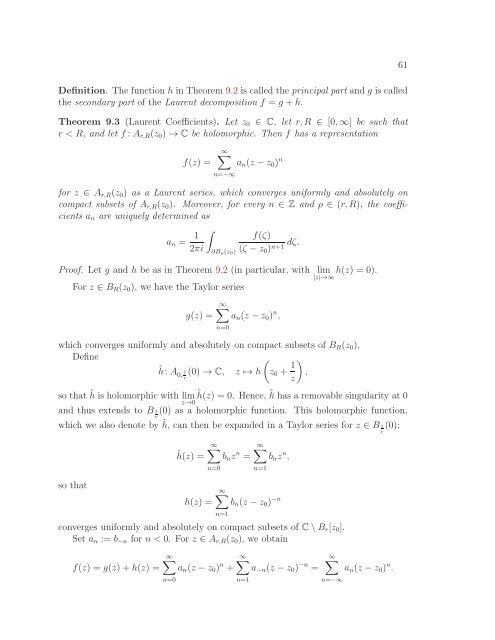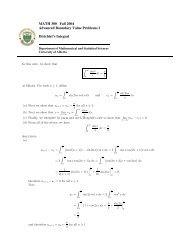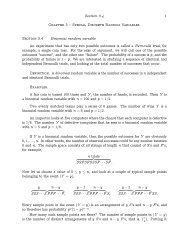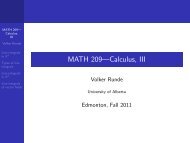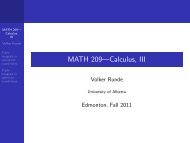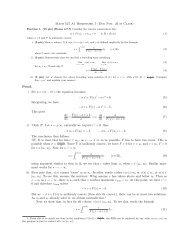Math 411: Honours Complex Variables - University of Alberta
Math 411: Honours Complex Variables - University of Alberta
Math 411: Honours Complex Variables - University of Alberta
Create successful ePaper yourself
Turn your PDF publications into a flip-book with our unique Google optimized e-Paper software.
Definition. The function h in Theorem 9.2 is called the principal part and g is called<br />
the secondary part <strong>of</strong> the Laurent decomposition f = g +h.<br />
Theorem 9.3 (Laurent Coefficients). Let z0 ∈ C, let r,R ∈ [0,∞] be such that<br />
r < R, and let f: Ar,R(z0) → C be holomorphic. Then f has a representation<br />
f(z) =<br />
∞�<br />
n=−∞<br />
an(z −z0) n<br />
for z ∈ Ar,R(z0) as a Laurent series, which converges uniformly and absolutely on<br />
compact subsets <strong>of</strong> Ar,R(z0). Moreover, for every n ∈ Z and ρ ∈ (r,R), the coefficients<br />
an are uniquely determined as<br />
an = 1<br />
2πi<br />
�<br />
∂Bρ(z0)<br />
f(ζ)<br />
dζ.<br />
(ζ −z0) n+1<br />
Pro<strong>of</strong>. Let g and h be as in Theorem 9.2 (in particular, with lim h(z) = 0).<br />
|z|→∞<br />
For z ∈ BR(z0), we have the Taylor series<br />
g(z) =<br />
∞�<br />
an(z −z0) n ,<br />
which converges uniformly and absolutely on compact subsets <strong>of</strong> BR(z0).<br />
Define<br />
�<br />
˜h: A 1<br />
0, (0) → C, z ↦→ h z0 +<br />
r<br />
1<br />
�<br />
,<br />
z<br />
n=0<br />
so that ˜ h is holomorphic with lim˜h(z)<br />
= 0. Hence,<br />
z→0<br />
˜ h has a removable singularity at 0<br />
and thus extends to B1<br />
r<br />
(0) as a holomorphic function. This holomorphic function,<br />
which we also denote by ˜ h, can then be expanded in a Taylor series for z ∈ B1<br />
r<br />
so that<br />
˜h(z) =<br />
h(z) =<br />
∞�<br />
bnz n =<br />
n=0<br />
∞�<br />
bnz n ,<br />
n=1<br />
∞�<br />
bn(z −z0) −n<br />
converges uniformly and absolutely on compact subsets <strong>of</strong> C\Br[z0].<br />
Set an := b−n for n < 0. For z ∈ Ar,R(z0), we obtain<br />
f(z) = g(z)+h(z) =<br />
n=1<br />
∞�<br />
an(z −z0) n +<br />
n=0<br />
∞�<br />
a−n(z −z0) −n =<br />
n=1<br />
∞�<br />
n=−∞<br />
(0):<br />
an(z −z0) n .<br />
61


